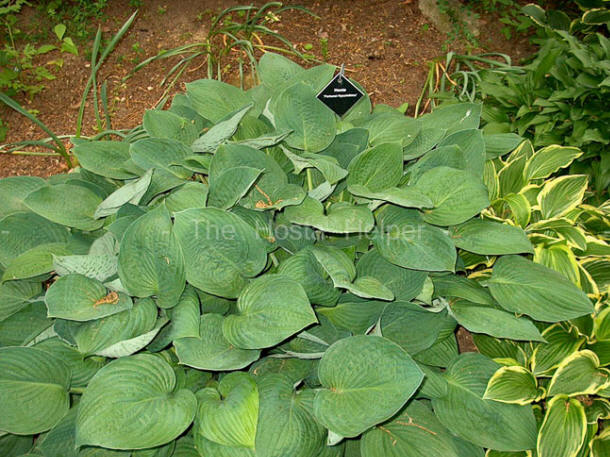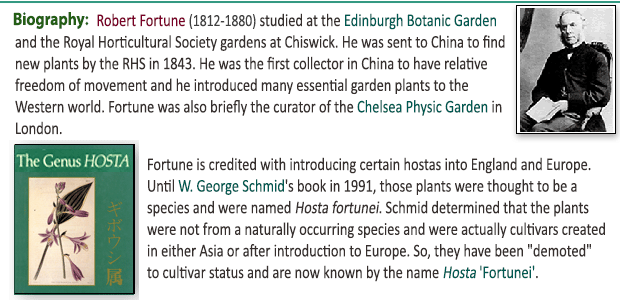|
  An excellent landscape plant, this hosta
which starts the season blue-green but later changes to dark
green forms a large size (23 inches high by 55 inches wide)
mound. Narrow, pale lavender flowers that are funnel shaped form on
36 inch tall scapes from late July into August. An excellent landscape plant, this hosta
which starts the season blue-green but later changes to dark
green forms a large size (23 inches high by 55 inches wide)
mound. Narrow, pale lavender flowers that are funnel shaped form on
36 inch tall scapes from late July into August.
Until Schmid (1991) changed the status of this plant from a
species to a cultivar, this plant had been known by several other names
including Hosta fortunei var hyacinthina, Hosta
hyacinthina, Hosta fortunei glauca, Hosta fortunei, Hosta glauca
and Hosta sieboldiana
 fortunei. It was registered by
The
American Hosta Society and Dr. Nils Hylander of Sweden in 1987 fortunei. It was registered by
The
American Hosta Society and Dr. Nils Hylander of Sweden in 1987
According to
The Hostapedia by
Mark Zilis (2009), "If any hosta should be called
Hosta 'Fortunei',
this is it. All of its mound, foliage, and flowering
characteristics can be considered typical of the Fortunei Group
as a whole. 'Fortunei Hyacinthina' has been one of the most
widely grown hostas for landscaping purposes due to its
excellent growth rate and durability."
 The New Encyclopedia of Hostas by
Diana
Grenfell (2009) states: "Origin: Unknown but thought to have evolved in a
European garden in the mid-nineteenth century...Tolerates
morning sun, which enhances the already excellent flowers but
causes the slight blueness in the leaves to
disappear...currently grown less for its garden value than its
propensity to throw sports...Flowers that resemble hyacinths and
are among the best in the genus." The New Encyclopedia of Hostas by
Diana
Grenfell (2009) states: "Origin: Unknown but thought to have evolved in a
European garden in the mid-nineteenth century...Tolerates
morning sun, which enhances the already excellent flowers but
causes the slight blueness in the leaves to
disappear...currently grown less for its garden value than its
propensity to throw sports...Flowers that resemble hyacinths and
are among the best in the genus."
This cultivar has been awarded
the Royal Horticultural Society's Award of Garden Merit in the
UK. May have been sold at one time as
'Mackwoods No. 11'.
The classic Hosta ‘Gold Standard ’ is a sport
of this cultivar.








|



